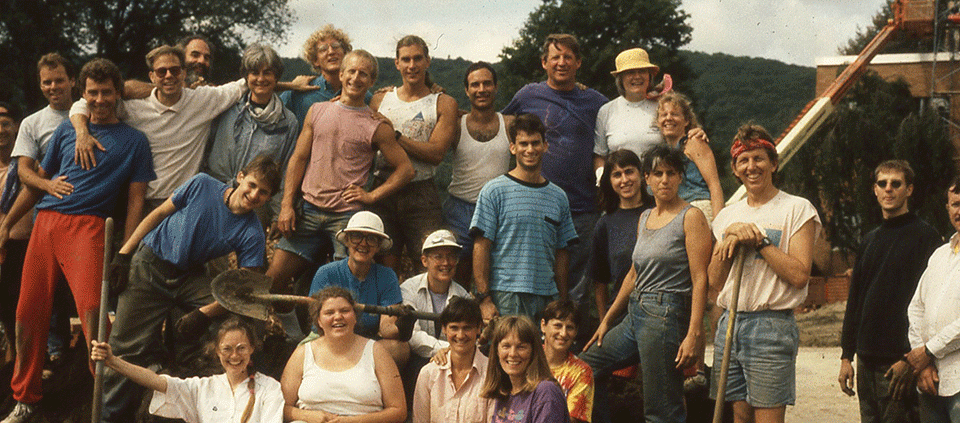On Being Gay at Kripalu: A Personal Recollection

When I arrived at Kripalu in October 1989, I was 40 years old. I had been out since I was 20. I had been in a 15-year relationship with a man. And I had participated actively in the gay liberation movement in Boston during the early 1970s, while I was a graduate student.
From my first day living on campus, I felt not only safe and accepted in the Kripalu community, but warmly embraced. (That's me at the top left in the photo above, in the the white shirt and glasses.) By 1989, there were already many other out gay folks in the community, and I was quickly integrated into their ranks. Among these were my friend Aruni, who arrived at Kripalu just a few months before I did, and who has been my best friend in the community ever since. (Here's her story.)
Kripalu is one of the most non-homophobic environments I’ve ever lived and worked in. Why has this community always been so accepting? I’ve often mused about this question.
A Forward-Thinking Ancient Tradition
One of the main reasons, I think, is that the yoga tradition is remarkably pluralistic by nature—and has been so for thousands of years. Our American attitude is so saturated with a Puritan ethic that it inevitably adopted rigid, moralistic views about relationships, sexuality, and marriage. We take the prevalence of this highly moralistic view for granted, I think, because this Puritan view is the water in which we have swum in this culture for these last two centuries. (H. L. Mencken famously quipped, “A Puritan is someone who is terrified that there is someone, somewhere, enjoying life.”)
But there are many other cultures that are much less rigid and judgmental about the body, sex, and intimacy. And, thankfully, the yogic culture is one of these.
There were exceptions at Kripalu, of course. The most notable of these was a situation that arose within my first-year study group, led by a more senior member of the community. He shocked our group by saying that he thought homosexuality was “wrong” and “dysfunctional,” and that the best thing I could do would be to remain celibate. This did not go over well, to say the least. Rebellion! Outrage! But here’s how it ended: This same guy is now a very dear friend, despite the rocky start. His views evolved slowly but surely, as he was confronted by the other gay residents. As a result, he was prompted to investigate his own sexuality. He and I now laugh about this episode.
Misadventures in Celibacy
Issues of gay sexuality were made massively more complicated by the fact that all members of the community were supposedly practicing brahmacharya—which meant, in effect, celibacy for the non-married. This led to sometimes-hilarious unintended consequences for us gay folk.
For example, in order to promote brahmacharya, the men and women in the community were routinely and strictly separated. We sat on different sides of the Main Hall, we ate on separate sides of the Dining Hall, we lived on two entirely different wings of the building. Had no one thought through the fact that this was a potential party for the gays among us? For example, I roomed for two years with my dearest friend, who was also gay. If we had been attracted to one another (which we were not), we could have been sleeping together in that room for two years.
There were other unintended consequences of brahmacharya. On one occasion, during a weeklong retreat, we were asked to line up in concentric circles, and as the circles passed one another in opposite directions, we were asked to acknowledge any “attractions” that we had—and, by acknowledging them, presumably, let the air out of the balloon. Well, this backfired. In that one exercise, I discovered at least five guys who acknowledged attractions to me—of which I had previously been entirely unaware. This circle exercise turned out to be nothing more than speed dating for many of us.
The Practicalities of Living Our Truth
At the end of the day, though, the yogic view of sex is not at all moralistic. It’s much more practical. The question is not about judgments of “right” and “wrong,” but about skillful and unskillful behavior. What kind of conduct leads to suffering, and what kind of conduct leads to happiness? How can I use my sexuality responsibly—to promote intimacy and self-development, and not merely self-indulgence?
This puts decisions about sexual and emotional behavior squarely where they belong—on the shoulders of each individual person’s own faculties of discernment. Indeed, everything in the yogic repertoire of practices is about systematically cultivating this discernment, in order to promote a happy and effective life in the world.
I will say this, though: When we old-timers get together in our rocking chairs to relive the old days, at least half of the talk will be tales of brahmacharya, and non-brahmacharya, and the rollicking, sitcom-worthy tangles we got ourselves into.
Find out about programs with Stephen Cope at Kripalu.
© Kripalu Center for Yoga & Health. All rights reserved. Email us to reprint.
Stephen Cope, MSW, Kripalu's Scholar Emeritus, is the best-selling author of The Great Work of Your Life and Yoga and the Quest for the True Self.
Full Bio and Programs